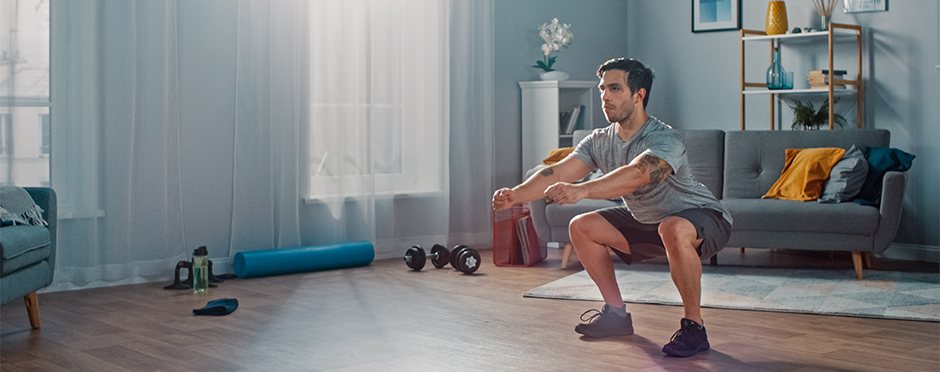
Tips from a PT: How to Perfect the Squat
Leave a CommentSquats are a foundational exercise movement. When you squat, you move at multiple joints via the action of several major muscle groups. A squat involves a hip hinge and bending at the knee and ankle. A squat is also a functional movement. Every time you sit down in a chair or get up from a seated position, you move through a squat pattern. Despite the familiarity of this movement pattern, it is easy to make errors with your squat form. So here are some tips to help you squat better (and maybe even with less pain or less risk of injury).
1. Pay attention to your foot placement
Your feet should be about hip-width apart or slightly wider. If your feet are too far apart, it can cause your knees to roll in towards each other. If your feet are too close together, there is less space for your pelvis to drop down as you flex at the hip. Your toes should be pointing relatively forwards. You can play around with toeing out slightly, but this will probably not be more than 30 degrees.
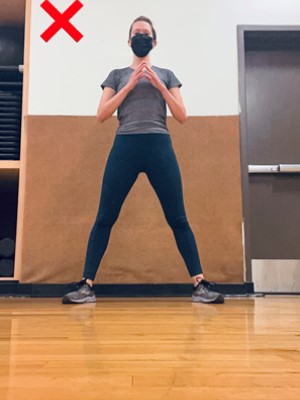
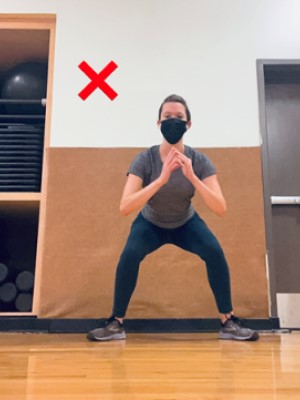
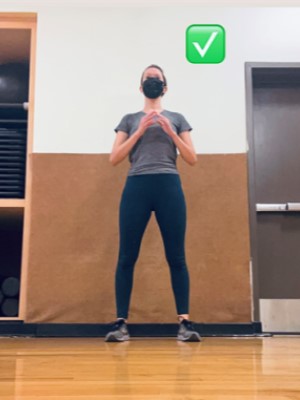
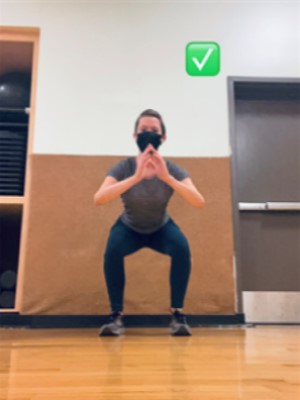
2. Knees over toes
When you squat down, you want your knees to be facing forwards. Avoid letting your knees internally rotate or point in towards each other. This position can place unwanted twisting on your knee joint. A good cue is to look for the middle of your kneecap to be aligned vertically with your second toe. Your knee and shin will come forwards over the ankle and foot. Be sure to keep the front of the shin relaxed to avoid gripping or tensing the muscles on the front of the shin, causing the ball of your foot or toes to lift from the floor.
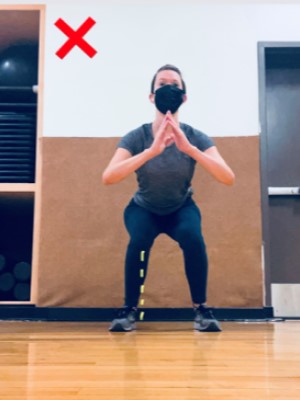
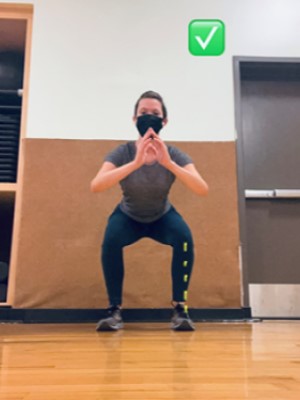
3. Keep your back straight
One error that is often seen at the spine with squatting is a posterior pelvic tilt. This position is excessive flexion of the lumbar spine and hip. The tailbone tucks under, creating outward rounding of the lower back instead of the slight arch that is anatomically correct. This position can put increased pressure on the structures of the lumbar spine. A posterior pelvic tilt is normal with very deep squats where you are going to the end range of hip flexion. But if you are squatting through a shorter range, you want to aim to keep a neutral spine. Poor core control and decreased hip flexibility are causes of posterior pelvic tilt. If it is a flexibility issue, you can try hamstring and piriformis stretch to improve your mobility.
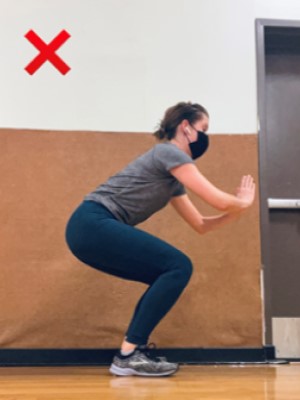
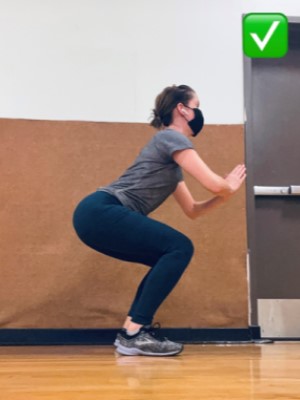
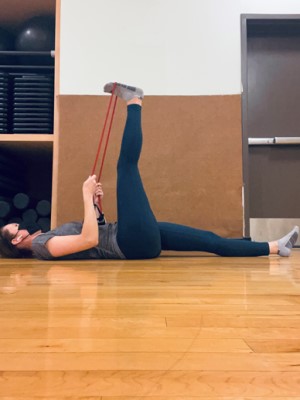
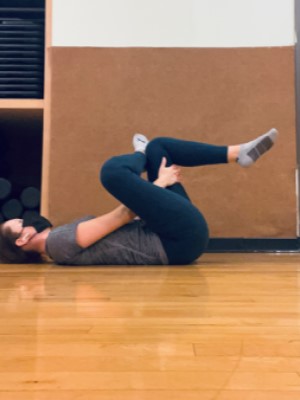
The image on the left shows a hamstrings stretch. To perform this stretch:
- Lie on your back with both legs extended and place a stretch strap, sturdy resistance band, belt, or towel wrapped around one foot.
- Holding the ends of the strap in your hands, raise the leg up towards the ceiling until you feel a stretching or pulling sensation in the back of the leg.
- Hold the stretch for 30 seconds and do 2-3 reps with each leg
The image on the right shows a piriformis stretch. To perform this stretch:
- Lie on your back with the knees bent and both feet placed on the floor.
- Then, place your right ankle over your left knee. If you feel a stretch in the back or side of the right hip, stay in this position.
- If you need more stretch, lift your left foot from the floor, bring both legs towards your chest, and hold this position.
- Hold for 30 seconds and do 2-3 reps with each leg.
4. Squat depth
How low should you go? The answer to this question will depend on several factors, including your joint mobility and flexibility, your workout goals and experience, and if you are dealing with any joint pain. If you are new to squatting, probably stay within a mid-range (no lower than the thigh parallel to the floor, or 90˚ of knee flexion). If you have knee pain, you may want to avoid deeper squats because the pressure on the knee joint tends to increase the lower you go. If you participate in a sport or activity where you are in a crouched position, it would be appropriate to practice deeper squatting.
5. Keep your weight in your heels
Your heels should stay in contact with the floor for a proper squat. If your heels are lifting, you lack flexibility in your calf muscles, or you are over-reliant on your quadriceps muscles to perform the movement. Keeping your heels in contact with the floor will reduce pressure on the front of the knee and help your glute and hamstrings muscles on the back of the leg assist in the performance of the squat movement. When a squat is correct, it is an efficient exercise because you strengthen several muscle groups simultaneously.
6. Modify as needed
Elevate your heels – If you cannot keep your heels down, even with focusing on this form, you can try using external support to aid in your foot placement. Weight plates work well for this, but you can roll up a towel or use a couple of textbooks if you have limited equipment.
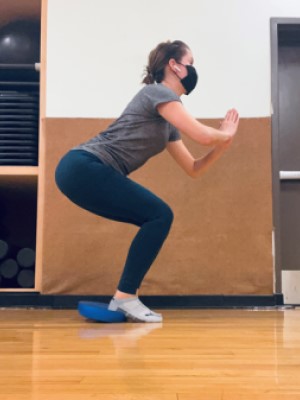
- Support your upper body – You can hold onto a handrail, treadmill arm, or suspension straps when you squat. This position helps get a better range of motion at the hip and keeps your knees from coming too far forward over your toes. It can also help take some pressure off the legs if you are new to squatting or returning after some time off due to an injury or surgery.
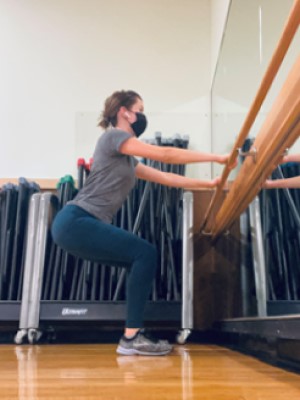
7. Take a selfie
The next time you do squats, use your cell phone camera to take a couple of videos of your workout. This way, you can see your form, note of any errors you are making and figure out what adjustments you could make for less pain or difficulty with squats.
Contact a Physical Therapist
If you have difficulty squatting or need additional feedback on your form, your local physical therapist is a great resource! Reach out to an Athletico near you to schedule a Free Assessment today. Free Assessments are available in-clinic and virtually through our Telehealth platform.
The Athletico blog is an educational resource written by Athletico employees. Athletico bloggers are licensed professionals who abide by the code of ethics outlined by their respective professional associations. The content published in blog posts represents the opinion of the individual author based on their expertise and experience. The content provided in this blog is for informational purposes only, does not constitute medical advice and should not be relied on for making personal health decisions.
